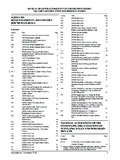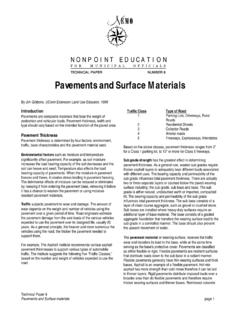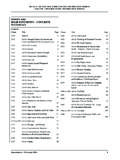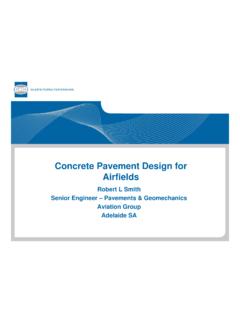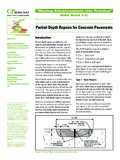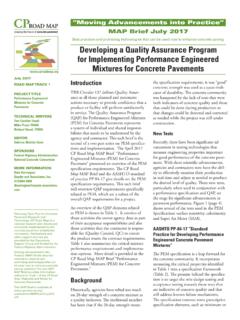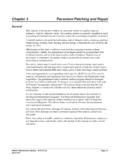Transcription of 2-6 Bituminous Pavements - CT.GOV-Connecticut's …
1 Construction Manual Volume 2 Construction Volume 2 Bituminous Pavements ver. (Aug 2010) Chapter 6 - Bituminous Pavements 2-601 Bituminous Concrete (HMA) Pavements 2-601A General Hot mix asphalt (HMA) pavement consists of coarse graded or dense graded hot mixed, hot laid, Bituminous paving mixtures. HMA mixtures are placed on either a prepared gravel base on new pavement structures, or an existing pavement structure for overlay projects.
2 HMA mixtures are composed of carefully graded coarse and fine aggregates, mineral filler when necessary, and asphaltic cement. 2-602 HMA Mixes and Applications Superpave HMA mixes have replaced Marshall hot-mix asphalt mixes in most cases. Superpave, like Marshall, is a mix design. Marshall mix designs are designated as Bituminous Concrete Class ( ). Superpave mixes are designated as HMA S*. Where S indicates Superpave and * indicates the sieve related to the nominal maximum aggregate size of the mix, HMA There are two (2) design levels for each nominal maximum aggregate size. The levels are based on the amount of traffic loading they will be exposed to during the designed life of the pavement . A local road, for example, would typically be a level 2. An interstate highway would typically be a level 3.
3 The design level has no bearing on the nominal maximum aggregate size. For example, a HMA level 2 and a HMA level 3 have the same nominal maximum aggregate size: inch ( mm). Typical usage for Superpave HMA mixes: HMA - Leveling course, thin lift maintenance overlays, over milled surfaces , bridge membrane systems Recommended compacted lift thickness: 1 inch (25 mm) HMA - Ideal as a surface course for local roads and some secondary roadways, leveling course, wedge course, over milled surfaces , certain bridge membrane systems, good for some limited access highways Recommended compacted lift thickness: inches (38 mm) HMA - Ideal surface course for all types of roadways including limited access highways and other higher volume roadways, also good for many wedge course applications Recommended compacted lift thickness.
4 2 inches (50 mm) HMA S1 - Base course, thick leveling courses Recommended compacted lift thickness: 3 to 4 inches (75 to 100 mm) Construction Manual Volume 2 Construction Volume 2 2-6. 2 ver. (Aug 2010) Bituminous Pavements Typical usage for Marshall HMA mixes: Class 3 - Bituminous lip curbing, paved ditch Class 2 - Temporary pavement for stage construction, leveling course, wedge course, over milled surface, transitions, etc. Recommended compacted lift thickness: inches (38 mm) Class 1 - Temporary pavement for stage construction, median cross-over, road widening, transitions, etc. Recommended compacted lift thickness: 2 inches (50 mm) 2-603 Contract Specifications The Standard Specifications for Roads, Bridges and Incidental Construction (commonly called the Standard Specifications) and the special provisions contain the information regarding material specification, methods of construction, methods of measurement, and bases of payment by which the contractor and the State are bound in the performance of the contract work.
5 2-604 Contract Plans Contract plans provide information related to Pavements for roadways. This information includes: The typical roadway cross sections describe the location, thickness of pavement , width of pavement and specific HMA mixture(s) to which the roadway is to be constructed. The plan sheets provide a visual description of the roadway. These plans also describe the roadway pavement width at specific locations by station. The cross sections provide information regarding finish pavement line and grade by station. The maximum thicknesses for Bituminous concrete are shown on the typical cross sections. When a HMA wearing surface is applied to a bridge deck, the slab plan and the miscellaneous details sheets in the bridge plans describe the HMA mixture and thickness of the overlay to be placed on bridge decks.
6 2-605 Production ResponsibilityHMA mixtures consist of coarse aggregate, fine aggregate, mineral filler if necessary, and asphalt cement combined to meet composition limits by weight and other characteristics as described in Section Proportioning of the materials, within the composition limits specified, is the responsibility of the Contractor or Producer. Approval of the source of all materials is required before such materials can be used. The Contractor or Producer must submit a job mix formula for each HMA mix design to be produced to the Department s Material Testing Laboratory for approval. When the job mix formula is approved, the Contractor is required to furnish a mixture that complies with the formula within the tolerances as described in Section Changes in the source of supply require approval by the Department s Material Testing Laboratory, and may require adjustment of the job mix formula by the Contractor.
7 The Chief Inspector, prior to any paving, must obtain copies of the approved job mix formula from the Laboratory testing representative. One copy is kept in the project files, and the other copy is kept by the Paving Inspector at the paving site. Construction Manual Volume 2 Construction Volume 2 Bituminous Pavements ver. (Aug 2010) 2-606 Inspection ResponsibilitiesThe responsibilities for acceptance inspection, sampling and testing are split between the Department s Material Testing Laboratory and the District forces. 2-606A Material Testing Laboratory The Assistant Manager, Division of Materials Testing, is responsible for providing the personnel required to examine and approve the Contractor's mixing plant and the trucks used for transporting the HMA mixes to the project.
8 2-606B District Responsibilities The Assistant District Engineer assigns the Project Engineer and inspection personnel required to receive the Bituminous materials and inspect the placement of the materials in accordance with the contract specifications at the paving site on the project. 2-606C Preliminary Inspection and Approval of PlantPlant equipment for the production and transportation of Bituminous concrete must conform to the requirements of the current Standard Specifications. Inspection, approval and certification that the plant is equipped in conformance with the requirements of the contract specifications are the function and responsibility of the Assistant Manager, Division of Materials Testing. Upon receipt of the Contractor's report of Anticipated Source of Materials, the Assistant Manager, Division of Materials Testing, will arrange for the inspection of the equipment at the plants selected to supply HMA.
9 Materials Testing will notify the District Engineer of the results of the inspection. Requirements for plant inspection can be found in the manual for the Division of Materials Testing. 2-607 Inspection Prior to Paving The Paving Inspector must perform the following checks prior to the start of paving: 2-607A Paving Equipment Before paving is started, all paving machines and rollers must be inspected and approved for conformance with specifications by the Paving Inspector or another assigned inspector. The Inspector should be sure that sufficient equipment, in good working order, is available so that once paving starts it can be continued without undue delays and shutdowns. 2-607B Paving Machines Most HMA mixtures are placed with a paver. The paver spreads the mixture, in either a uniform layer of a desired thickness or a variable layer to a desired elevation and cross section, ready for compaction.
10 Construction Manual Volume 2 Construction The paver consists of two basic units: a tractor and a screed. The tractor receives, conveys and augers the mixture to the screed and propels the screed forward. The tractor may be mounted on either rubber tires or crawlers. In addition to the engine, the tractor unit has a hopper for receiving the mix from the haul trucks, conveyors to move the mix through the flow control gates to the augers, flow gates to prevent overloading the augers, and augers to evenly spread the mix in front of the screed. Rollers are mounted on the front of the tractor to push the haul trucks during the dumping process. The rollers should turn freely so the trucks will have little effect on paver operation..1 The screed performs the actual placing of HMA material to the desired width and thickness or elevation, as shown in the sketch in Figure The screed is towed by the tractor and is free to float up or down until the bottom of the screed is parallel with the grade over which it is traveling.










